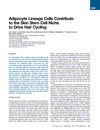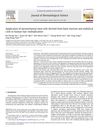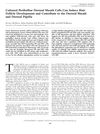The study investigated the role of CD34+ cells, enriched from adipose tissue, in hair morphogenesis using a model involving GFP transgenic mice. CD34+ cells, when mixed with fetal mouse keratinocytes and dermal fibroblasts, were found to contribute significantly to the development of hair follicles in reconstituted skin tissue, unlike CD34- cells. Histological and immunofluorescent analyses indicated that CD34+ cells integrated into dermal sheath structures, suggesting their specific involvement in hair morphogenesis. Additionally, CD34+ and SVF cells participated in blood vessel formation, but only CD34+ cells showed a strong potential for multiple differentiation, highlighting their role as adipose-derived mesenchymal stem cells (ADMSCs) with enhanced capabilities in skin development.
 499 citations
,
September 2011 in “Cell”
499 citations
,
September 2011 in “Cell” Fat-related cells are important for initiating hair growth.
 41 citations
,
September 2010 in “Journal of dermatological science”
41 citations
,
September 2010 in “Journal of dermatological science” Bone marrow and umbilical cord stem cells can help grow new hair.
 330 citations
,
December 2009 in “Cell stem cell”
330 citations
,
December 2009 in “Cell stem cell” SKPs are similar to adult skin stem cells and could help in skin repair and hair growth.
58 citations
,
April 2009 in “Current stem cell research & therapy” Adult stem cells can become many different cell types, offering wide possibilities for repairing damaged tissues.
201 citations
,
August 2006 in “Cell and Tissue Research”  208 citations
,
December 2003 in “Journal of Investigative Dermatology”
208 citations
,
December 2003 in “Journal of Investigative Dermatology” Certain cells from hair follicles can create new hair and contribute to hair growth when implanted in mice.
158 citations
,
May 2003 in “Journal of Investigative Dermatology” Hair growth is influenced by dynamic changes in hair follicle cells, which could help treat hair loss.
745 citations
,
February 1992 in “Trends in genetics” Hair follicles create different cell layers and proteins, controlled by various molecules.



